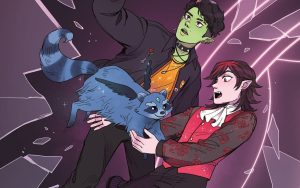The GameCube was an interesting chapter in gaming history. While it lacked the overall depth of third-party developers that helped make the PlayStation 2 the winner of the sixth generation of consoles, it was also home to several experimental takes on established formulas and fresh IP that embraced unique gameplay styles. This approach was often a winner for GameCube players, with exclusive titles like Eternal Darkness and Pikmin pushing the boundaries of standard gameplay genres.
One such title was Lost Kingdoms, a relatively obscure entry in the GameCube canon. Coming from FromSoftware, the same developer that would later shift the action game genre landscape with Dark Souls and Elden Ring, Lost Kingdoms presented a unique approach to the fantasy action genre that has never truly been matched. While the overall game was met with mixed reviews when it launched, it’s been stuck in my brain since I first played it over two decades ago on the GameCube — and it’s high time for a return.
FromSoftware has been a fixture in the gaming space for decades, launching in 1986 as an early business app developer before shifting into video games. While the company found its biggest success with the Dark Souls games and subsequent action titles like Bloodborne and Elden Ring, it’s also been behind other enduring series like King’s Field and Armored Core. One of their most unique titles, however, remains Lost Kingdoms.
Published by Activision in the west, Lost Kingdoms initially appears to be a fairly straightforward fantasy action game focused on Princess Katia of the land of Argwyll. When her father is lost in a mysterious fog, she ventures out to discover what happened to him. The narrative of Lost Kingdoms steadily does play with the tropes of the genre in some compelling ways, including an apparent villain named Helena who proves to be on a similar journey to her own.
What made Lost Kingdoms stand out from other fantasy games of the same type is the focus on deckbuilding for combat. Gifted a runestone before her adventure, Katia uses a deck of mystical cards to summon spells and creatures to overcome her enemies. The player can upgrade the cards and transform them into stronger new forms. The enemies she defeats can be captured and converted into new additions to her deck, with over 100 unique cards available for players to mix and match with.
This mechanic put an interesting spin on the fantasy action genre because the card-based combat doesn’t translate to the typical turn-based strategy. Instead, players are still left scrambling across the battlefield to avoid enemy attacks, forcing them to reposition to better utilize their abilities for the best effect. With a standard elemental rock-paper-scissors format to the cards and enemies alike, players are forced to effectively treat their abilities less as a strategic deck and more as a spellbook for desperate attacks.
Lost Kingdoms was a strange title, but a fitting one for the GameCube. As opposed to the typical action and adventure of a Legend of Zelda title, Lost Kingdoms focused more on combat customization through the deck-building mechanic. Figuring out the right balance of cards for specific challenges proved to be a clever strategic element of the game, forcing players to put more thought into their planning for further adventures.
The relative weakness of Katia as a fighter on her own merits also raised the stakes in some exciting ways. With little in the way of direct combat skills, players had to move Katia through dangerous scenarios with a mix of care and cunning. Dodging around attacks was key, with Katia unleashing a creature or transforming into the shape of her spells to deploy a crushing attack.
Players were dealt four cards from their deck while roaming the overworld, each one mapped to one of the A, B, X, and Y buttons for quick access to different spells. It ensured the deck-building still fed naturally into the action of the genre. It was a memorably unique way to approach combat, especially as the rest of the game’s design was reminiscent of the typical fantasy adventure genre. With a story that gradually took on greyer shades of morality while escalating the overarching threat into a truly foreboding force, Lost Kingdoms was a clever experiment that played with the conventions of the action fantasy game in unique ways.
Lost Kingdoms launched in North America on May 29, 2002. With an additional multiplayer system that encouraged more experimentation with deck building and combat, Lost Kingdoms was a consistently entertaining title that had fun with the unique concept — even if the overall execution left something to be desired. This was the overall reception to the game from the gaming media at the time, which largely complimented the game’s deck-building elements while criticizing the repetitive music and relatively short length. While the game did receive a sequel in 2003 with Lost Kingdoms II, neither title necessarily rocked the gaming world. The series has lain relatively dormant ever since.
However, with FromSoftware’s modern successes turning it into a much more high-profile developer, the time might be right to revisit Argwyll. The focus on blending deck-building strategy with standard action-adventure elements was a clever one. It was a fun tweak, moving the genre away from the typical hack-and-slash or RPG elements that typically define the genre.
While Lost Kingdoms was criticized for its lackluster visuals and music, the company has become increasingly famous for its art design in games like Elden Ring. A new take on the story could add more morally dubious depth to the kind of narrative explored previously. Instead of the standard evil villains like Thalnos, who appeared late in the game, a new take on Lost Kingdoms could explore the concept of multiple heroic figures coming into conflict for the sake of their own kingdom, raising moral quandaries about the player’s otherwise heroic actions. Given how much FromSoftware has evolved in the years since Lost Kingdoms, it would be fascinating to see what they could do with the concept in the present day.
The post It’s Been 23 Years, and I Still Haven’t Gotten Over This Weird FromSoftware RPG appeared first on ComicBook.com.




